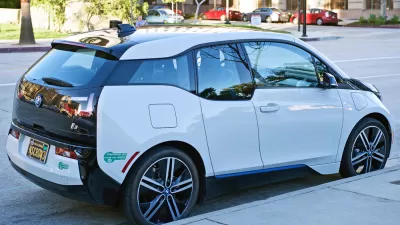A bill working its way through the California State Legislature would require the state to reduce petroleum its consumption by half in 15 years. CALmatters, a nonprofit journalism venture, seeks to find out if it is even possible.
California under Gov. Jerry Brown and its majority Democratic legislature may be more committed to fighting climate change than any other state, and they have legislation to show for it. As posted here in April, SB 350, the Clean Energy and Pollution Reduction Act of 2015 "would (r)educe oil consumption by 50 percent, require renewables to supply 50 percent of electricity generation, and double energy efficiency in existing buildings," all by 2030
Kate Galbraith investigates the possibility of the first goal—halving oil consumption in motor vehicles, for CALmatters, "a nonpartisan, nonprofit journalism venture committed to explaining how California’s state Capitol works and why it matters."
She begins her report at a Stockton fair that promotes electric vehicles (EVs). The event, sponsored by the Charge Ahead initiative, an outcome of SB 1275 that addresses the inherent inequity of the state rebate program by targeting lower income Californians, particularly those with more polluting vehicles.

Credit: Chevrolet 2015 EV Spark
Galbraith speaks with a woman whose 20-year-old Toyota Camry has flunked its smog test. While she's wowed by the all-electric Chevy Spark she test-drove, she chooses to repair the Camry, notwithstanding the generous rebates offered her toward purchase of the Spark.
"If we’re talking about transportation petroleum use, then the goal [to cut use in half by 2030] probably isn’t possible," said John German, a Michigan-based senior fellow with the International Council on Clean Transportation. A key problem, he said, is that people hold onto cars and trucks for a long time, an average of more than 11 years for American cars.
However, that viewpoint is refuted by "Jeffrey Greenblatt, a scientist at the Lawrence Berkeley National Laboratory, [who] estimates that by 2030, a number of transportation policies already in existence will enable the state to cut petroleum use by cars and trucks to about 70 percent of their 2014 level," writes Galbraith. "Besides federal fuel-economy standards, these include support for public transit and a state goal of having 1.5 million emissions-free vehicles by 2025."
In fact, the Charge Ahead initiative enables eligible low income households to "cash in their clunkers and use that voucher with clean car rebates or for car-sharing programs and public transportation," according to Vien Truong, Environmental Equity Director for The Greenlining Institute.
However, "trends are moving in the wrong direction," writes Galbraith. Fuel consumption has been increasing since July 2013. Vehicle miles traveled (VMT) has also been increasing since 2013
So, can technology enable California to meet its oil reduction goal? It can help! In addition to increased electric vehicle sales, "the International Council on Clean Transportation estimates that recent federal fuel-economy standards could cause greenhouse gas emissions from light-duty vehicles nationwide to fall 28 percent by 2030 compared to 2015," writes Galbraith, though that doesn't automatically equate with reduced fuel consumption.
It would be nice to be able to quantify to fuel reduction projected due to:
- Increased EV sales
- Increased fuel efficiency standards
- VMT reduction programs, e.g., public transit
- Low carbon fuel standard, though not mentioned in the article
Notwithstanding Greenblatt's optimistic outlook, it clearly will be difficult for California to cut oil consumption in half, particularly in a time of falling oil prices.
FULL STORY: Can California cut gas use by half in 15 years? Probably not

Alabama: Trump Terminates Settlements for Black Communities Harmed By Raw Sewage
Trump deemed the landmark civil rights agreement “illegal DEI and environmental justice policy.”

Study: Maui’s Plan to Convert Vacation Rentals to Long-Term Housing Could Cause Nearly $1 Billion Economic Loss
The plan would reduce visitor accommodation by 25% resulting in 1,900 jobs lost.

Planetizen Federal Action Tracker
A weekly monitor of how Trump’s orders and actions are impacting planners and planning in America.

Wind Energy on the Rise Despite Federal Policy Reversal
The Trump administration is revoking federal support for renewable energy, but demand for new projects continues unabated.

Passengers Flock to Caltrain After Electrification
The new electric trains are running faster and more reliably, leading to strong ridership growth on the Bay Area rail system.

Texas Churches Rally Behind ‘Yes in God’s Back Yard’ Legislation
Religious leaders want the state to reduce zoning regulations to streamline leasing church-owned land to housing developers.
Urban Design for Planners 1: Software Tools
This six-course series explores essential urban design concepts using open source software and equips planners with the tools they need to participate fully in the urban design process.
Planning for Universal Design
Learn the tools for implementing Universal Design in planning regulations.
Caltrans
Smith Gee Studio
Institute for Housing and Urban Development Studies (IHS)
City of Grandview
Harvard GSD Executive Education
Toledo-Lucas County Plan Commissions
Salt Lake City
NYU Wagner Graduate School of Public Service




























